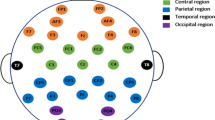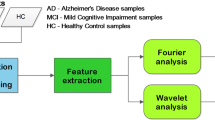Abstract
Alzheimer’s disease (AD) is a significant neurological disorder with deficits in cognitive and behavioral brain functions. Although there is no cure for AD, early diagnosis is essential in slowing the disease and increasing the patient’s quality of life. In addition, the diagnosis of the disease includes costly tests and a complex process that an experienced specialist must evaluate. Therefore, this study presents a new computer-aided diagnosis system (CAD) allowing automatic AD diagnosis by EEG signals. The present study used EEG recordings of 24 healthy controls and 24 AD patients. The proposed algorithm includes a preprocessing step using multi-scale principal component analysis (MSPCA) for noise removal, decomposition of the signal into subcomponents with the variational mode decomposition (VMD) method, and extraction of statistical features from each subcomponent. The achievement of the recommended method in distinguishing between healthy individuals and AD patients was tested by applying various ensemble learning techniques and decomposition methods. As a result of the empirical studies, the maximum classification accuracy of AD diagnosis was obtained as 98.42 ± 0.06 using the Rotation Forest algorithm.







Similar content being viewed by others
Data Availability
The data used in this study are taken from the publicly available data set. The data set is available at "https://osf.io/s74qf/ "[25].
References
A. Alberdi, A. Aztiria, A. Basarab, On the early diagnosis of Alzheimer’s disease from multimodal signals: a survey. Artif. Intell. Med. 71, 1–29 (2016). https://doi.org/10.1016/j.artmed.2016.06.003
Z. Aslan, M. Akın, Automatic detection of schizophrenia by applying deep learning over spectrogram images of EEG signals. Traitement Du Signal 37, 235–244 (2020). https://doi.org/10.18280/ts.370209
V. Bairagi, EEG signal analysis for early diagnosis of Alzheimer disease using spectral and wavelet based features. Int. J. Inform. Technol 10, 403–412 (2018). https://doi.org/10.1007/s41870-018-0165-5
V. Bajaj, R.B. Pachori, Classification of seizure and nonseizure EEG signals using empirical mode decomposition. IEEE Trans. Inf. Technol. Biomed. 16, 1135–1142 (2012). https://doi.org/10.1109/TITB.2011.2181403
B.R. Bakshi, Multiscale PCA with application to multivariate statistical process monitoring, vol. 44 (Wiley, London, 1998), pp.1596–1610. https://doi.org/10.1002/aic.690440712
R.H. Blank, Alzheimer’s disease and other dementias: an introduction. Soc. Pub. Policy Alzheimer’s Dis. U. S. (2019). https://doi.org/10.1007/978-981-13-0656-3_1
R. Cassani, M. Estarellas, R. San-Martin, F.J. Fraga, T.H. Falk, Systematic review on resting-state EEG for Alzheimer’s disease diagnosis and progression assessment. Dis. Mark. (2018). https://doi.org/10.1155/2018/5174815
J. Dauwels, F. Vialatte, A. Cichocki, Diagnosis of Alzheimer’s disease from EEG signals: where are we standing? Curr. Alzheimer Res. 7, 487–505 (2010). https://doi.org/10.2174/156720510792231720
K. Dragomiretskiy, D. Zosso, Variational mode decomposition. IEEE Trans. Signal Process. 62, 531–544 (2014). https://doi.org/10.1109/TSP.2013.2288675
J. Duan, Y. Liu, H. Wu, J. Wang, L. Chen, C.L.P. Chen, Broad learning for early diagnosis of Alzheimer’s disease using FDG-PET of the brain. Front. Neurosci. (2023). https://doi.org/10.3389/fnins.2023.1137567
N.E. Huang, Z. Shen, S.R. Long, M.C. Wu, H.H. Snin, Q. Zheng, N.C. Yen, C.C. Tung, H.H. Liu, The empirical mode decomposition and the Hubert spectrum for nonlinear and non-stationary time series analysis. Proc. R. Soc. A Math., Phys. Eng. Sci. 454, 903–995 (1998). https://doi.org/10.1098/rspa.1998.0193
J. Jeong, EEG dynamics in patients with Alzheimer’s disease. Clin. Neurophysiol. 115, 1490–1505 (2004). https://doi.org/10.1016/j.clinph.2004.01.001
P. Juan, S. Amezquita, M. Nadia, C.M. Francesco, M. Silvia, A. Hojjat, A novel methodology for automated differential diagnosis of mild cognitive impairment and the Alzheimer’s disease using EEG signals. J. Neurosci. Methods. 322, 88–95 (2019). https://doi.org/10.1016/j.jneumeth.2019.04.013
C. Kaur, A. Bisht, P. Singh, G. Joshi, EEG Signal denoising using hybrid approach of variational mode decomposition and wavelets for depression. Biomed. Signal Process. 65, 102337 (2021). https://doi.org/10.1016/j.bspc.2020.102337
S. Khare, V. Bajaj, A hybrid decision support system for automatic detection of Schizophrenia using EEG signals. Comput. Biol. Med. 141, 105028 (2022). https://doi.org/10.1016/j.compbiomed.2021.105028
N. Kulkarni, Use of complexity based features in diagnosis of mild Alzheimer disease using EEG signals. Int. J. Inform. Technol. 10, 59–64 (2018). https://doi.org/10.1007/s41870-017-0057-0
N.N. Kulkarni, V.K. Bairagi, Extracting salient features for EEG-based diagnosis of Alzheimer’s disease using support vector machine classifier. IETE J. Res. 63, 11–22 (2016). https://doi.org/10.1080/03772063.2016.1241164
K.H. Liu, D.S. Huang, Cancer classification using rotation forest. Comput. Biol. Med. 38, 601–610 (2008). https://doi.org/10.1016/j.compbiomed.2008.02.007
F.J. Massey, The Kolmogorov–Smirnov test for goodness of fit. J. Am. Stat. Assoc. 46, 68–78 (1951). https://doi.org/10.1080/01621459.1951.10500769
B. Oltu, M. Akşahin, S. Kibaroğlu, A novel electroencephalography based approach for Alzheimer’s disease and mild cognitive impairment detection. Biomed. Signal Process. 63, 102223 (2021). https://doi.org/10.1016/j.bspc.2020.102223
W.H. Organization, Dementia: a public health priority, (2012)
P. Pandey, K.S. Seeja, Subject independent emotion recognition from EEG using VMD and deep learning. J. King Saud Univ. Comput. Inform. Sci. 34, 1730–1738 (2022). https://doi.org/10.1016/j.jksuci.2019.11.003
C. Patterson, World alzheimer report 2018, (2018).
H.W. Peers, Practical nonparametric statistics. J. R. Stat. Soc. Ser. A. 144, 370 (1981)
A.M. Pineda, F.M. Ramos, L.E. Betting, A.S.L.O. Campanharo, Quantile graphs for EEG-based diagnosis of Alzheimer’s disease. PLoS One (2020). https://doi.org/10.1371/journal.pone.0231169
S.J. Ruiz-Gómez, C. Gómez, J. Poza, G.C. Gutiérrez-Tobal, M.A. Tola-Arribas, M. Cano, R. Hornero, Automated multiclass classification of spontaneous EEG activity in Alzheimer’s disease and mild cognitive impairment. Entropy 20, 35 (2017). https://doi.org/10.3390/e20010035
M. Safi, S. Safi, Early detection of Alzheimer’s disease from EEG signals using Hjorth parameters. Biomed. Signal Process Control 65, 102338 (2021). https://doi.org/10.1016/j.bspc.2020.102338
S. Sun, C. Zhang, D. Zhang, An experimental evaluation of ensemble methods for EEG signal classification. Pattern Recognit. Lett. 15, 2157–2163 (2007). https://doi.org/10.1016/j.patrec.2007.06.018
S. Taran, V. Bajaj, Clustering variational mode decomposition for identification of focal EEG signals. IEEE Sens. Lett. 2, 1–4 (2018). https://doi.org/10.1109/LSENS.2018.2872415
S. Tosserams, L. Etman, P. Papalambros, An augmented Lagrangian relaxation for analytical target cascading using the alternating direction method of multipliers. Struct. Multidiscip. Optim. 31, 176–189 (2006). https://doi.org/10.1007/s00158-005-0579-0
L.R. Trambaiolli, N. Spolaôr, A.C. Lorena, R. Anghinah, J.R. Sato, Feature selection before EEG classification supports the diagnosis of Alzheimer’s disease. Clin. Neurophysiol. 128, 2058–2067 (2017). https://doi.org/10.1016/j.clinph.2017.06.251
K.D. Tzimourta, N. Giannakeas, A.T. Tzallas, L.G. Astrakas, T. Afrantou, P. Ioannidis, N. Grigoriadis, P. Angelidis, D.G. Tsalikakis, M.G. Tsipouras, EEG window length evaluation for the detection of Alzheimer’s disease over different brain regions. Brain Sci. 9, 81 (2019). https://doi.org/10.3390/brainsci9040081
Z. Ullah, M. Jamjoom, A deep learning for Alzheimer’s stages detection using brain images. Comput. Mater. Contin. (2023). https://doi.org/10.32604/cmc.2023.032752
G.I. Webb, MultiBoosting: a technique for combining boosting and wagging. Mach. Learn. 40, 159–196 (2000). https://doi.org/10.1023/A:1007659514849
T. Zhang, W. Chen, M. Li, AR based quadratic feature extraction in the VMD domain for the automated seizure detection of EEG using random forest classifier. Biomed. Signal Process Control. 31, 550–559 (2017). https://doi.org/10.1016/j.bspc.2016.10.001
Author information
Authors and Affiliations
Corresponding author
Ethics declarations
Conflict of interest
The authors declare no conflict of interest.
Ethical Approval
This article does not contain any studies with human participants or animals performed by any authors.
Informed Consent
Informed consent was obtained from all participants in the study.
Additional information
Publisher's Note
Springer Nature remains neutral with regard to jurisdictional claims in published maps and institutional affiliations.
Rights and permissions
Springer Nature or its licensor (e.g. a society or other partner) holds exclusive rights to this article under a publishing agreement with the author(s) or other rightsholder(s); author self-archiving of the accepted manuscript version of this article is solely governed by the terms of such publishing agreement and applicable law.
About this article
Cite this article
Aslan, Z. A Novel Computer-Aided Diagnostic System for Alzheimer’s Diagnosis Using Variational Mode Decomposition Method. Circuits Syst Signal Process 43, 615–633 (2024). https://doi.org/10.1007/s00034-023-02496-y
Received:
Revised:
Accepted:
Published:
Issue Date:
DOI: https://doi.org/10.1007/s00034-023-02496-y




